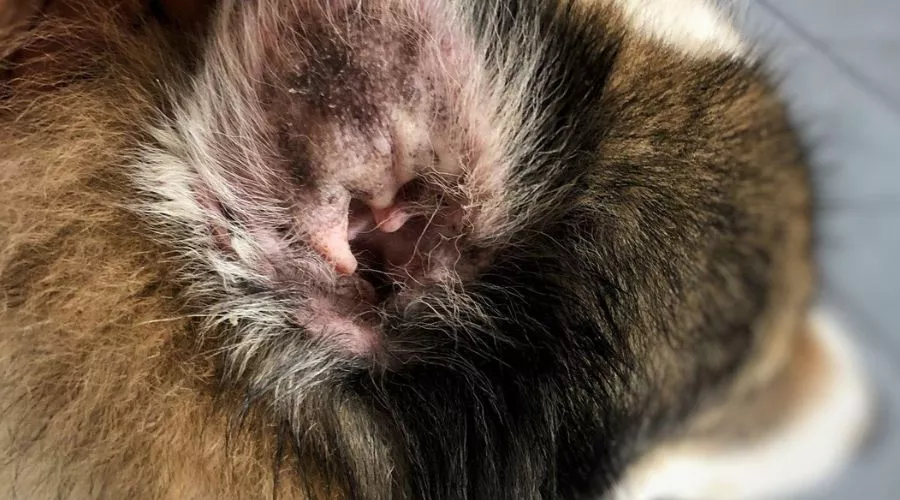A yeast infection in a dog’s ears can be a painful and uncomfortable experience for your furry friend.
A variety of factors, including certain foods, can cause these infections. Knowing what foods can lead to yeast infections in a dog’s ears can help you take preventive measures and keep your pup healthy and happy.
Some specific foods commonly cause yeast infections in dogs’ ears, such as corn, wheat, and soybeans. These foods contain high sugar levels, which can lead to an overgrowth of yeast in a dog’s ear canal.
Additionally, processed, canned, or sugary foods can feed an existing yeast infection, making it worse. Knowing which foods to avoid can help you prevent a yeast infection from developing in the first place.
What is a yeast infection in a dog’s ear?

A yeast infection in a dog’s ear is an overgrowth of the fungus Candida albicans.
This fungus is usually present on a dog’s skin, but it is kept in check by its immune system. It may cause ear infections if the dog’s immune system is compromised and it becomes too abundant.
The most common cause of a yeast infection in dogs’ ears is allergies, including food allergies. Other risk factors include prolonged exposure to water, unclean or excessively moist conditions, and damage to the dog’s ears.
Dogs with long, floppy ears are most at risk because they have many folds and creases in which yeast can grow.
A yeast infection in a dog’s ears can be painful and lead to other health problems, including ear mites and bacterial infections. It can be treated with multiple medications and other treatments, depending on the severity of the disease.
However, it is best to avoid infections first, so watching what you feed your dog is essential.
Symptoms of Yeast Infection

If your dog’s ears are smelly or have a thick, white buildup, it could be a sign of a yeast infection. Your dog may also be scratching or pawing at its ears, another common symptom. It would help if you also were on the lookout for any signs of redness, swelling, or excessive pain in your dog’s ears.
If you see any of these symptoms, you must take your dog to the vet as soon as possible. Left untreated, a yeast infection in a dog’s ears can lead to serious health issues, including bacterial infections and ear mites.
If your dog’s ears smell very red and have thick, white, crusty buildup, they may have a yeast infection. Dogs with a yeast infection in their ears often scratch, shake their heads, or paw at the ears, leading to a rupture and even more irritation.
What foods cause yeast infections in a dog’s ear?
- Corn – Corn is one of the most common causes of yeast infections in dogs’ ears. Avoid feeding your pup corn-based foods, and clean their ears regularly.
- Wheat – Wheat is high in sugar and can cause an overgrowth of yeast in a dog’s ears. Feeding your dog high-sugar foods, like wheat, can lead to a yeast infection.
- Soybeans contain trypsin inhibitors, which can interfere with and even stop a dog’s diet from being properly digested. This can lead to an overgrowth of yeast in a dog’s ears and cause a yeast infection.
- Processed foods – Processed foods are often high in sugar and can lead to an overgrowth of yeast in a dog’s ears. Feeding your dog an overly processed diet can cause a yeast infection.
- Canned foods – Canned foods are often high in sugar and can lead to an overgrowth of yeast in a dog’s ears. Feeding your dog a diet of overly sweet foods can cause a yeast infection.
- Sugary foods can lead to an overgrowth of yeast in a dog’s ears. Feeding your dog overly sweet foods can cause a yeast infection.
How to prevent a yeast infection
You can do a few things to prevent a yeast infection in your dog’s ears. ↗
First, you should make sure to clean your dog’s ears regularly. You may consider using a cleaning solution specially formulated for dogs’ ears.
You can also avoid feeding your dog high-sugar foods and keep their ears clean and dry at all times. If your dog does end up with a yeast infection, make sure to treat it as soon as possible.
Antifungal medication can prevent a yeast infection in a dog’s ears and prevent it from spreading.
FAQs
What foods should dogs avoid with yeast infections?
Yeast infections in dogs can be tricky, so it’s essential to ensure your pup is eating foods that won’t exacerbate the problem. The most important thing to remember when feeding your pup food with a yeast infection is to avoid sugar and carbohydrates. Yeast infections feed off sugar and carbs, so eliminating them from the diet is essential. This prevents sweet treats like cookies, cakes, and other sugary snacks. It also means avoiding starches like rice, potatoes, and pasta. In addition to avoiding sugar and carbs, it’s essential to avoid foods with high yeast content. This includes bread, beer, and anything made with yeast or yeast extracts. Any food with high-fat content should also be avoided as it can be difficult for your pup to digest. Finally, ensuring your dog gets enough vitamins and minerals in its diet is vital. A balanced diet is key for keeping yeast infections at bay. Aim for foods high in essential vitamins and minerals like calcium, phosphorus, magnesium, and vitamin A.
What kills a yeast infection in dogs’ ears?
The first thing you should do is take your dog to the vet for an examination and diagnosis. The vet may prescribe a topical antifungal cream or ointment and oral medications to help clear up the infection. You can also try home remedies to help treat the disease. Cleaning your dog’s ears regularly with a mild cleaning solution can help keep yeast infections at bay. Additionally, adding plain yogurt to your dog’s diet can help to restore the natural balance of bacteria in their gut and reduce the chances of yeast overgrowth. You can also use ingredients like apple cider vinegar and hydrogen peroxide to flush out the ears and reduce the amount of yeast. These solutions should be used with caution, though – make sure you dilute them with equal water before using them.





